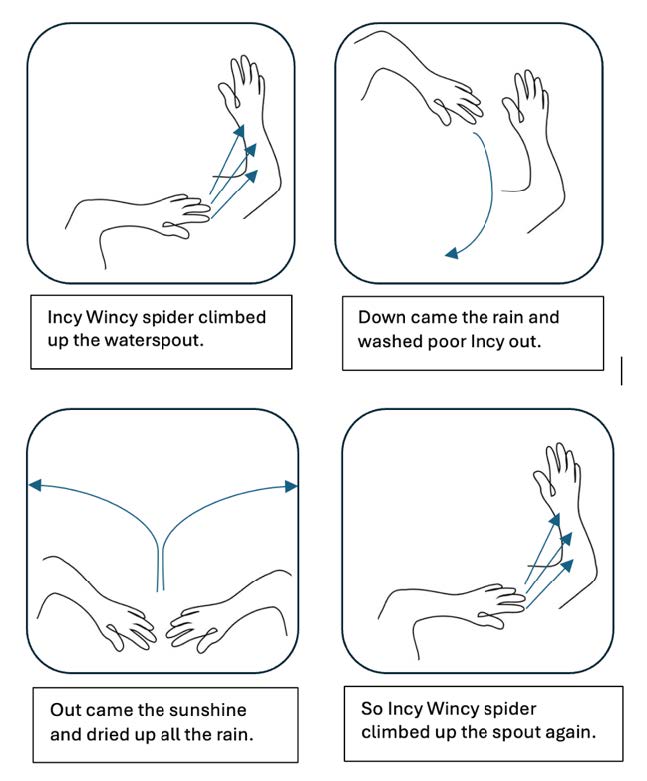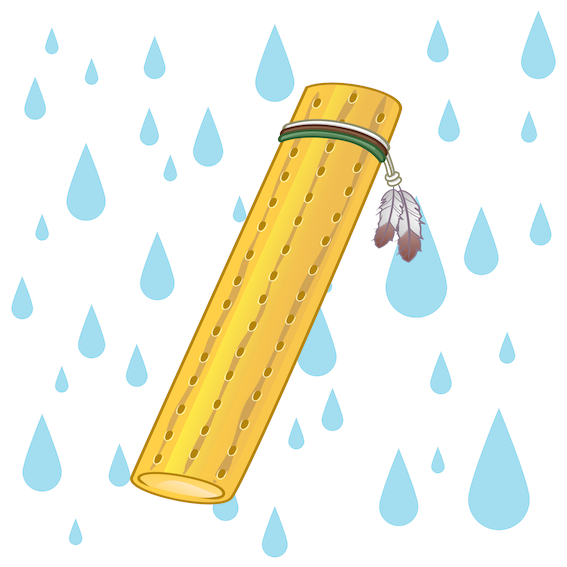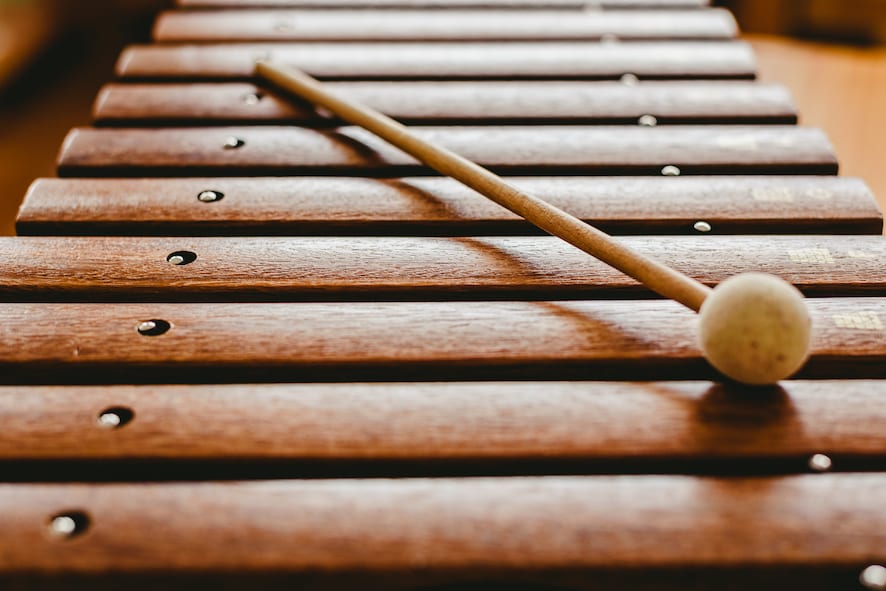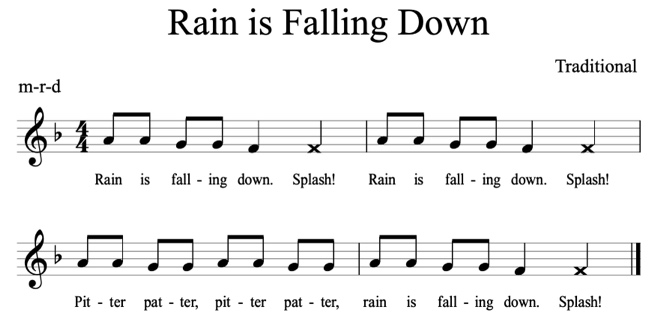
Prep. Lesson 8. Playing with the beat
- Non-melodic percussion Difficulty:
 Prior learning: None
Prior learning: None
![]()
Students use graphic notation as a stimulus to explore sounds on a djembe.
![]() Lyrics
Lyrics
Round and round the garden,
Like a teddy bear,
One step, two steps,
Tickle you under there!
 Success Criteria
Success Criteria
- This activity is a precursor to experiencing musical notation. It creates an awareness that sounds can be linked to written symbols.
- Project the graphic notation card for "Round and Round the Garden" on the board or display a laminated poster.
- Ask students to observe the visuals and see if they can guess the rhyme based on the symbols and patterns.
- Sing or recite "Round and Round the Garden" with the students, pointing to each section on the graphic notation card as you go. Encourage students to follow along, reinforcing the visual representation of the rhyme.
- Introduce the djembe and explain that they will use the drum to represent each part of the rhyme with different sounds.
- "Round and round the garden like a teddy bear": Demonstrate scraping fingers in a circular motion on the drum skin to mimic "round and round."
- Ask for volunteers to try this technique, exploring the texture of the drum surface.
- "One step, two steps": Show two distinct single beats on the djembe using separate hands. Invite students to try, focusing on creating clear, spaced beats.
- "Tickly under there": Use fingertips to make light, quick pitter-patter sounds resembling tickling. Let students experiment with this motion, aiming for a soft, scattered sound.
- Once students understand each technique, perform the rhyme as a class, with everyone following along using the djembe techniques for each line.
- Rotate volunteers so that different students can demonstrate each part of the rhyme on the djembe.
- After practising, discuss which sounds best represent each part of the rhyme.
![]() Students will learn to perform an ensemble piece using graphic notation and develop their beat, inner hearing and conducting skills.
Students will learn to perform an ensemble piece using graphic notation and develop their beat, inner hearing and conducting skills.
![]() In this activity, the students will respond to known graphic notation symbols, but they will now be presented with them in varying orders rather than in their known sequence. This provides a preliminary introduction to the concept of sight reading.
In this activity, the students will respond to known graphic notation symbols, but they will now be presented with them in varying orders rather than in their known sequence. This provides a preliminary introduction to the concept of sight reading.
Early conducting activities should be very basic. In this instance, the group is being led (conducted) by students who point to different sections of a graphic notation card. The skills to encourage at this stage are using clear gestures and moving from one graphic to the next in a timely way to reflect the beat and phrase lengths.
 Success Criteria
Success Criteria
- I can follow graphic notation to play my part in the ensemble.
- I can use inner hearing to know when it’s my turn to play.
- I can guide the ensemble confidently as a conductor.
- Perform ‘Round and Round the Garden’ with an instrumental accompaniment played by three students with a drum each – one for each section of the notation card. (If more drums are available, this group can be expanded to 2 or 3 students per card, creating a larger ensemble.)
- Use the graphic notation card from the last activity as the guide for their performance.
- Ask instrumentalists to play the piece without any lyrics (using audiation (inner hearing) to know when it is their turn to play.)
- Point to the sections of the card in a different order and ask instrumentalists to follow.
- ‘Conducting’ the ensemble in this way will create new musical arrangements.
- After demonstrating this, invite individual students to come out and ‘conduct’.
![]()
Students perform a rhyme with a steady beat and accompanying actions and analyse the form.
![]()
Note: this piece may have been taught as a song. Here, it is used as a poem to draw attention to the contrast between speaking and singing voices. In this activity, students’ attention is drawn to aspects of the rhyme’s structure – namely, four lines (or phrases). When analysing the actions, they also notice that one of these is repeated (in lines 1 and 4). They do not need to go deeper into further analysis – this rudimentary observation is sufficient preliminary exposure to the notion of musical form.

- Teach the new poem, ‘Incy Wincy Spider,’ using the simultaneous imitation/whole-song method. (This is a holistic approach to teaching a simple piece, keeping the entire rhyme intact throughout the process.
- Students follow along simultaneously with your actions whilst you say the rhyme.
- As the rhyme is repeated, students will gradually pick up the words and join in.
- Before each rhyme repetition, ask students various questions (e.g. Who is this poem about? What happens in the story of this poem? What is a waterspout? What direction is the spider headed in various lines?
- Repeat the song each time to check the answers to each question.
- Once the words and actions are secure, ask students how many different lines are in the rhyme (4).
- How many different actions occur in the rhyme? (3)
- Which lines repeat an action? (lines 1 and 4) Why is this action repeated? (because the spider is doing the same thing).
 Success Criteria
Success Criteria
- I can perform a rhyme by keeping a steady beat whilst doing actions.
- I can hear how a rhyme is divided into phrases.
![]()
Students create an instrumental accompaniment to a rhyme and use inner hearing to play a musical piece.
![]()
In this activity, students begin by accompanying a rhyme with actions. They then remove the spoken words to accompany the actions only. Finally, by using their inner hearing (audiation) skills, they play without any words or actions, creating a stand-alone piece of music.


- Show students a xylophone, rain stick and triangle and demonstrate how sound is produced on each:
- Xylophone – played with a felt mallet. Strike the bars in the centre to achieve the best resonance and allow mallets to bounce back rather than stop on the bars (as this will deaden the sound).
- Rain stick: Hold it perpendicular to the ground and gradually turn it upside down. The filling (usually rice, beads, or small stones) will move down the tube, creating a sound like falling rain.
- Triangle: Hold the triangle (RH) by the strap and strike gently with a metal beater (LH). Keep RH close to the metal to steady the instrument, but don’t allow fingers to contact the metal, as this will deaden the sound.
- Ask students to suggest appropriate instruments for each gesture used in ‘Incy Wincy Spider’.
- Arrive at a consensus (steer the discussion so the solution is xylophone for lines 1 and 4 – moving in step motion from low to high); rain stick for line 2; triangle for line 3).
- Ask volunteers to come to the front to play each instrument.
- Accompany rhyme with gestures (remainder of the class) and instruments (volunteers out the front).
- Remove words and accompany gestures only.
- Remove gestures and perform as a stand-alone instrumental piece.
- Repeat to allow a range of students to have a turn with the instruments.
 Success Criteria
Success Criteria
- I can play instruments to accompany a rhyme.
- I can use inner hearing to know when it is my turn to play in an ensemble.
![]()
Students create and perform an instrumental accompaniment to a song.
![]()
In this activity, students will create an accompaniment to a song, having first experienced movements and body percussion that will provide stimuli for this.

![]() Lyrics
Lyrics
Rain is falling down. Splash!
Rain is falling down. Splash!
Pitter patter, pitter patter,
Rain is falling down. Rain is falling down. Splash!

- In this activity, students will create an accompaniment to a song, having first experienced movements and body percussion that will provide stimuli for this.
- The class stands in a circle. Teach the new song, ‘Rain is Falling Down’, using a simultaneous imitation/whole song approach (as described above).
- Ask students various questions (e.g. How many different actions are in the song? (3).
- How many times does the first action occur in the song? (3 – on ‘Rain is falling down.’)
- What about the next action? (3 – on ‘Splash!’) … the other action? (1 – on ‘Pitter patter, pitter patter.’) What is the song about?
- What water-sound words are in the song? Repeat the song each time to check students’ answers.
- Ask students to turn to their right and place their hands on the shoulders of the person in front of them. (We will now ‘play the song on their backs’.)
- ‘Rain is falling down’ – gently run fingers from shoulder to lower back.
- ‘Splash!’ – clap.
- ‘Pitter patter, pitter patter.’ – use fingertips to make gentle pattering on the middle of the back.
- Face the other direction and repeat.
- Bring out a rain stick, cymbal, gong, egg shaker or small maraca and ask students to suggest appropriate instruments for each gesture. (When striking a gong or cymbal, allow the mallet to bounce off the metal for the greatest resonance.
- The instrument does not need to be struck hard to make a suitable, sound. Discourage such temptations!
- Egg shakers or small maracas are best for little hands. They can be shaken on the beat, but children have greater control when holding just one maraca and tapping it into the palm of their other hand.)
- Arrive at a consensus as to how each instrument will be played. Ask volunteers to come to the front and play.
- Accompany rhyme with gestures and instruments.
- Repeat to allow a range of students to have a turn with the instruments.
 Success Criteria
Success Criteria
- I can perform appropriate movements and body percussion with other students to accompany a song.
- I can play instruments to accompany a song.
![]()
Students perform a melodic accompaniment to a known song.
![]()
In this activity, students create a 2-movement pattern to the beat. They will by now be familiar with doing this, but this time, as you steer them towards using a pattern that moves from a high level to a lower level (e.g. head/shoulders). This is aimed at unconsciously preparing them for two different pitch levels, which will later be demonstrated on the melodic percussion.
A bordun is an ostinato accompaniment using the first and fifth notes of the scale. It is a very useful pedagogical tool for use with pentatonic material, as it can be repeated throughout a musical piece, making it a simple accompaniment, and it provides a solid bass grounding, anchoring the tonality very clearly.
Bordun Pattern:

- Revise known song, ‘Rain Rain’.
- Ask students to suggest 2-movement patterns to keep the beat.
- Select a few ideas that show the first beat being performed at a higher level than the second (e.g. head/shoulders or clap/patsch) and ask the whole class to perform these whilst singing the song a couple of times.
- Demonstrate transferring this pattern onto two chime bars (pitched C’ and A).
- Alternatively, use an alto xylophone and remove all unnecessary bars. There is no need to focus too much on mallet technique here.
- The aim is mainly to have students use two mallets (alternating) and play in the centre of the bars for the best resonance.
- Ask for volunteers. (If more bars are available, recruit more volunteers.)
- Perform the song with you playing a broken bordun (in quavers) on F and C – preferably on a bass xylophone if available.
 Success Criteria
Success Criteria
- I can create a 2-movement beat pattern with the first movement at a higher level than the second.
- I can play a 2-note melody on melodic percussion to accompany a song.
Suggested lessons
Y1. Beat II

Y1. Beat III

Y1. Beat IV

